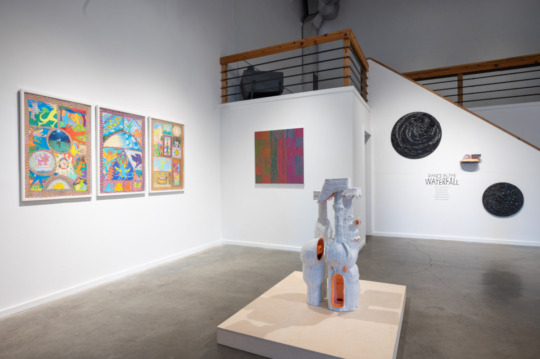
[cont.]
SweetWater’s Goldilocks tale — one of precise timing and award-winning quality — started on Fulton Industrial Boulevard. In 2003, it moved to a larger facility in Armour Circle Industrial Park, where it fronted an existing generic shed with a sleek black Miesian tasting room. Architecturally subversive as a haven for the experimental ethos, this facility welcomed movement across the envelope, engaging the street and the brewery interior with lively activity. However, owners Freddy Bensch and Kevin McNerney hired the utterly bland firm of MacGregor Associates in 2012 to elongate its complex and boost production capacity. While the interior juxtaposes a larger temple to the production of beer with an elevated pair of tasting and event spaces full of handsome furniture, the renovated building’s exterior consists only of a balcony and an unremarkable branded mural. They have the ability and talent to aspire to loftier architectural goals and ideas.
SweetWater’s case involved the most significant immediate potential for brewery architecture in Atlanta, but the future could present much more. Former Georgia Craft Brewers Guild leader, John “JR” Roberts of Max Lager’s brewpub, states that “Georgia could support nine breweries the size of SweetWater and still have room left over for sales.” Based on their escalated production and current facility conditions, Terrapin and Red Hare are currently undergoing an expansion while Jailhouse is likely in need of one.

Each brewery faces unique challenges. Situated on the periphery of Athens, Terrapin’s building features a relentless prefabricated concrete double tee facade, yet it also has an extensive outdoor gathering space. Not spatially limited, John Cochran and Brian “Spike” Buckowski’s fantastically creative outfit (and the third oldest commercial brewery in Georgia) needs to consider the importance of architecture in its plans for the future, especially if it wants to stay ahead of its new — and comparably innovative — downtown auto repair shop rehabilitating rival, Creature Comforts. Red Hare’s comparably generic CMU industrial shed in suburban Marietta belies the awe-inspiring stainless steel shrine of the tanks inside, placed in a typically efficient array reminiscent of the Karnak hypostyle hall. However, the brewery looks poised to relocate closer to Marietta’s most famous architectural oddity, the Big Chicken. Finally, Jailhouse’s brewery in Hampton, Georgia, refutes the standard by converting an historic jail of slender, urban-conscious proportions into a factory for incarcerated beer innuendoes and escapist sculpture.

In a region with such traditional aesthetic values, a brewery willing to rehabilitate a generic industrial box into an experimental interior should complement that audacity with an equally experimental exterior. The exterior is often forgone due to cost or lack of imagination. A common misconception about experimental architecture is that it is expensive and thus only for the financially stout. Although Atlanta is stocked with architectural practices that can provide a base solution for little expenditure, it also has several firms capable of challenging high-concept design questions that could turn a brewery into a socially responsible and affordable marketing device.
The design of a brewery presents itself as an architectural challenge of cross-programming par excellence. The contemporary iteration of this building typology typically synthesizes the demands of a manufacturing and distributing complex, bar with event space, gaming hub, aging cellar, and office. Embracing the client as co-designer, the brewery architect becomes a scientific choreographer, creating an arena for a dance of complex machinery, biochemical processes, and experimental researchers. Using a science-on-display concept to educate and entice the tasting audience, the brewery architect functions additionally as a logistics consultant, enacting design ideas that improve efficiency and boost creative output. Instead of a tabula rasa warehouse, the architect can design the brewery in such a way that it is reminiscent of REX’s Wyly Theatre, with specific, functional presets that can be manipulated to create endless usable variety.

The omnipresence of future reorganization or expansion renders a given interior as one prone to spontaneous physical modulation. The act of brewing is a performance art piece, replicating creation in the most fundamental sense. Atlanta’s brewers willingly showcase their creativity through their beer and associated packaging. Yet, the final frontier for these brewing pioneers should be elevating their experimental domains to the level of art. Craft brewing leaders Dogfish Head and 21st Amendment have already prioritized sustainable and experimental design in their new facilities currently under construction. With the state government finally responding to the craft brewing renaissance that could extend innovation across several related industries, architectural experimentation should follow as well.
Nick Kahler is an intern architect at HOK, an independent artist, and a writer based in Atlanta.
Beer, Bricks and Mortar
Related Stories
Reviews
Reviews
Mood Ring
Dance in the waterfall at Red Arrow, Nashville
Margaret Jane Joffrion reviews the feeling montages and logic of colors found in Dance in the waterfall at Red Arrow, Nashville.
Everyday Love by Richard Dial at Institute 193, Lexington
Daniel Fuller reviews the crafted metal chairs reflecting tenderness and the human condition in Everyday Love by Richard Dial at Institute 193, Lexington.
How To Get Free
Pieced together through collage, video capture, and a spoken poem, artist Kay-Ann Henry presents the intricacies of Afro-religious practices and Jamaica's particular expression of obeah, pocomania, and kumina.




